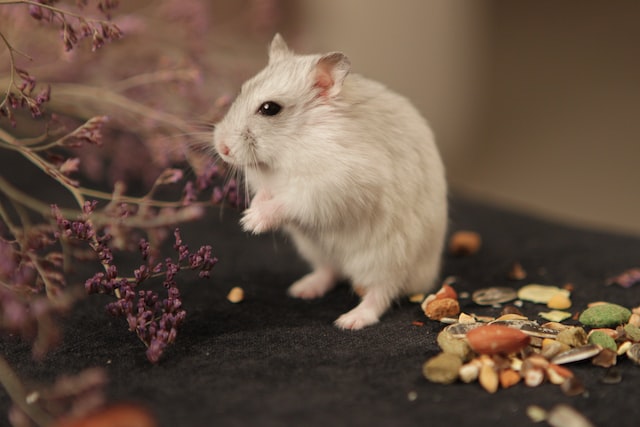If you’ve ever owned a hamster, you know they are full of energy and constantly on the move. One behavior you might have noticed is your hamster standing up on its hind legs.
But have you ever wondered what this behavior means? Is your hamster trying to stretch its legs, or is there a deeper meaning behind this behavior?
This blog post will delve into the world of hamsters and explore why your hamster might be standing up. From territorial behavior to communication, we’ll cover it all and help you better understand your furry little friend.
To learn more, keep reading!
The Significance of a Hamster Standing Up

Here are some common reasons for a hamster to stand up:
1. To get a better view of their surroundings
Hamsters have poor eyesight and rely on their sense of smell and hearing to navigate their environment. By standing on their hind legs, they can get a better view of what is happening around them and potentially spot potential threats or food sources.
2. To communicate with their owners or other hamsters
Standing on its hind legs can signify excitement or affection in hamsters, and other vocalizations or movements often accompany it. For example, a hamster may stand on its hind legs and vocalize when it wants to play or be fed.
3. To mark their territory
Hamsters have scent glands on their feet and tail, and standing up allows them to deposit their scent on objects and surfaces in their environment. This can be a way for hamsters to communicate with other hamsters and establish their dominance within the group.
4. As a sign of stress or discomfort

If a hamster is standing on its hind legs and vocalizing or pacing, it could signify feeling anxious or threatened. Several factors, such as loud noises, unfamiliar surroundings, or a lack of hiding places, can cause this.
5. Due to health issues
A hamster standing on its hind legs and trembling could be experiencing pain or discomfort due to an injury or illness. If you notice any unusual behavior in your hamster, it is essential to consult a veterinarian to rule out any potential health problems.
6. To exercise
Hamsters are active creatures, and standing on their hind legs can be a way for them to stretch and exercise their muscles. This is especially common in younger hamsters with a lot of energy to burn.
Now that we have explored the significance of a hamster standing on its hind legs let’s take a look at how you can encourage healthy standing behavior in your hamster.
How to Encourage Healthy Standing Behaviour in Your Hamster

If you’re a hamster owner, you know these cute little critters need plenty of exercises to stay healthy and happy.
Encouraging your hamster to stand and engage in upright activities can be a great way to ensure they get the physical activity they need. Here are some tips for promoting healthy standing behavior in your hamster:
1. Set up a standing wheel in its cage.
A standing wheel is a larger version of a traditional exercise wheel that allows your hamster to stand up on their hind legs while running. This wheel type is great for encouraging your hamster to engage in more upright activity and can help prevent them from becoming sedentary.
Just make sure to choose a standing wheel that is the appropriate size for your hamster and is made of a safe, non-toxic material.
2. Offer your hamster plenty of toys and play areas that encourage standing and climbing.
This is a great way to keep them active and engaged. It can include climbing structures, tunnels, and other interactive toys. Just be sure to supervise your hamster when using these toys to ensure they are safe and not at risk of injury.
3. Consider adding a standing perch or platform to your hamster’s cage.
This can give them a place to stand and stretch their legs, which can help prevent them from becoming stiff and inactive. Just make sure that the perch or platform is stable and secure, and comfortable for your hamster to reach.
4. Encourage your hamster to stand by offering them treats or toys when they are in an upright position.
This can help them associate standing with positive reinforcement. It can also encourage them to stand more often, benefiting their overall health and well-being.
5. Make sure your hamster has enough space to move around and stand.
This is important in promoting healthy behavior. Hamsters need plenty of room to run and play, so if their cage is too small, they may need more space to stand and move around comfortably.
Be sure to choose a cage that is appropriately sized for your hamster and provides plenty of space for them to explore and play.
Generally, encouraging healthy standing behavior in your hamster requires physical activity, a healthy diet, and social interaction. By providing your hamster with plenty of opportunities to engage in natural behaviors and meet its emotional needs, you can help promote a happy and healthy lifestyle.
Wrapping Up
Standing on hind legs is typical for hamsters and can have various meanings. Pay attention to your hamster’s behavior and provide plenty of opportunities for physical activity, a healthy diet, and social interaction to encourage healthy standing.
You should consult a veterinarian if you notice unusual behavior or changes in your hamster’s standing habits. Following these guidelines can help your hamster stand tall and live a happy and healthy life.








